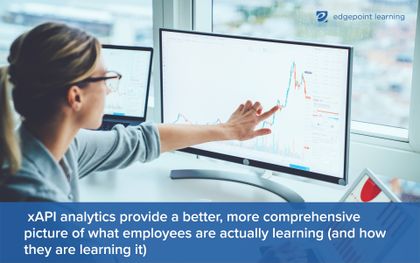xAPI: How To Use In eLearning And Major Benefits
Corey Bleich
🍿 4 min. read
Welcome to your 101 guide to xAPI in eLearning
You’ve designed an incredible eLearning experience for your employees, but now comes the hard part. How will you know what employees are actually getting from their experience and measure what they have actually learned? Enter xAPI – the next level of user experience tracking. Here's what you should know about this eLearning technology.
What is xAPI?
xAPI is an eLearning software specification that was first released in 2013. Originally called Tin Can API because of its ability to share information between learning systems (like talking through connected tin cans), this new way of tracking learning focused on the experience of the learner (that’s the “x” in the name).
Built on the idea that it’s not enough to simply track whether or not learners completed a class or training, xAPI was designed to track previously less-quantifiable metrics, including:
- Offline learning
- Interactive learning
- Real-world performance
- Transitions between platforms (e.g., from desktop to mobile device)
This “experience API” focuses on what the user actually does, not just through the learning platform but also out in the world with hands-on training, mentoring, and informal learning experiences.
So, what is xAPI? It’s one of the best tools to measure how learners are doing in a more holistic way.

xAPI examples
xAPI involves tracking more than just a percentage score on a quiz. You can use xAPI to:
- Create personalized training for sales teams
- Teach and assess emergency resuscitation efforts for EMTs
- Use employee feedback to improve trainings
- Figure out better talent development strategies (and track talent within your company)
These examples capitalize on the better, more rounded data that xAPI can provide.
What is xAPI used for?
Put simply, when learners complete an activity with xAPI enabled, they send a statement of it to a learning record store (LRS). The LRS receives, stores, and accesses learning records (also called activity statements) across many different platforms (including mobile apps). The statement, sent to an LRS, is phrased very simply, as in, “I did this.”
An LRS does not replace your learning management system (LMS). Your LMS has some features that an LRS does not, including:
- Ability to schedule classes
- Management of social interactions
- Management of content
- Delivery of quizzes and other activities
An LRS pairs well with SCORM (shareable content object reference model.) SCORM measures concrete activities such as attendance and completed quizzes or assessments, with one problem: it's confined to one platform and lacks real-world metrics. SCORM only tracks online learning, whereas xAPI can cover the vast ocean of learning that occurs elsewhere.
Too many acronyms? The breakdown is this: xAPI works to better assess how well your training is meeting the needs of employees using more accurate tools for measuring and reporting learning across systems.
What are the major xAPI benefits?
Major benefits cover everything from more detailed xAPI analytics that improve learning experiences to seamless (and fast) set-up.
Offers a more detailed view of employee learning
One of the main xAPI benefits is the detail it provides for each person using it. Progress in xAPI is measured not only in test scores and completion rates but also through offline activities. For employees who learn best offline or through hands-on training, xAPI authentically assesses how they are progressing towards their training goals.

Allows you to design better learning experiences
When you understand better what’s working (and what’s not) in your learning experiences, you can take measurable steps to make them better. Maybe your employees would prefer a more social approach, or perhaps mentorships are doing the trick.
This information also helps you make better use of your available resources for higher-quality learning.
Offers better system integration
Think of xAPI as an all-in-one learning tool. It can be expensive in both time and resources to coordinate multiple learning systems, but xAPI conformant systems are faster and cheaper.
They also have the capability to migrate old information to the new system. This saves time and gets you up and running (with better training) sooner.
Where to learn more about xAPI in eLearning
This is just a primer, and you could spend days deep-diving into the technical aspects of xAPI. It can feel like a lot to take in. The Association for Talent Development (ATD) has great resources to explore xAPI, as does the Learning Technologies Group.
At the end of the day, you don’t need to be a technological wizard to move to the next level of eLearning and xAPI. There are plenty of authoring tools available if your team can't manage the tech heavy lifting.
Prefer a more human touch, or still have questions? EdgePoint Learning can help you implement xAPI across your learning experiences!
When you are ready to explore the possibilities for authentic learning and training assessment, get in touch.
